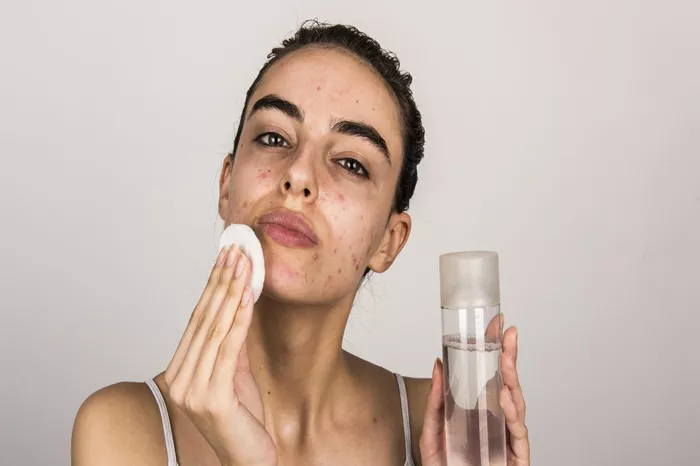Pimples, also known as acne, can be a frustrating and persistent skin condition. They occur when hair follicles become clogged with oil, dead skin cells, and bacteria. While pimples are common, especially among teenagers and young adults, they can affect individuals of all ages. The good news is that with the right skincare routine, you can manage and reduce pimples effectively. This guide provides a detailed, step-by-step routine tailored to combat pimples, supported by science and expert recommendations.
Understanding the Causes of Pimples
Hormonal Changes
Hormonal fluctuations, especially during puberty, menstruation, or pregnancy, are a leading cause of pimples. These changes often increase oil (sebum) production in the skin.
Excess Oil Production
Overactive sebaceous glands produce too much oil. This can mix with dead skin cells, creating a plug that clogs pores.
Bacterial Infections
The bacteria Cutibacterium acnes thrive in clogged pores, triggering inflammation and the formation of pimples.
Lifestyle and External Factors
Poor diet, stress, lack of sleep, and using comedogenic skincare products can worsen acne. External pollutants and improper skincare can also exacerbate the condition.
Step-by-Step Skincare Routine for Pimples
Consistency and patience are key to managing acne. Follow these steps daily to improve your skin’s health and clarity.
1. Gentle Cleansing: The Foundation of Any Routine
Cleansing removes dirt, oil, and makeup, preventing pore clogging.
Use a Mild, Non-Comedogenic Cleanser
Look for sulfate-free cleansers with active ingredients like salicylic acid or benzoyl peroxide. These help to unclog pores and reduce bacteria.
Example Ingredients: Salicylic acid for exfoliation, benzoyl peroxide for killing acne-causing bacteria.
Cleanse Twice Daily
Wash your face in the morning and evening. Avoid over-cleansing, as it can strip the skin of its natural oils and cause dryness.
Avoid Harsh Scrubbing
Use your fingertips to gently massage the cleanser into your skin. Scrubbing can irritate the skin and worsen pimples.
2. Exfoliation: Removing Dead Skin Cells
Exfoliation prevents the buildup of dead skin cells that clog pores.
Choose Chemical Exfoliants Over Physical Scrubs
Use products with alpha hydroxy acids (AHAs) like glycolic acid or beta hydroxy acids (BHAs) like salicylic acid. These gently dissolve dead skin cells without causing microtears.
Limit to 2–3 Times Per Week
Over-exfoliating can damage the skin barrier and increase sensitivity. Start slowly and monitor your skin’s reaction.
3. Toning: Restoring Balance
Toners help to rebalance the skin’s pH and prepare it for subsequent products.
Use Alcohol-Free Toners
Look for soothing ingredients like witch hazel, niacinamide, or tea tree oil. These reduce inflammation and redness.
Apply with Cotton Pads or Hands
Gently pat the toner onto your face instead of rubbing it in.
4. Targeted Treatments: Addressing Active Pimples
Treatments should focus on reducing inflammation and preventing new breakouts.
Spot Treatments
Use products with benzoyl peroxide, sulfur, or salicylic acid. Apply directly to pimples after cleansing and toning.
Retinoids
Prescription-strength retinoids like tretinoin or over-the-counter options like adapalene are excellent for unclogging pores and speeding up skin cell turnover. Use these at night, as they increase sensitivity to sunlight.
Hydrocolloid Patches
These patches absorb excess fluid and protect pimples from picking or irritation. They work best on whiteheads.
5. Moisturizing: Hydrating Without Clogging
Even acne-prone skin needs hydration. Skipping moisturizer can lead to dryness, which triggers more oil production.
Opt for Lightweight, Oil-Free Moisturizers
Look for “non-comedogenic” labels. Gel-based or water-based moisturizers are ideal for oily and acne-prone skin.
Ingredients to Seek
Hyaluronic acid for hydration, ceramides for repairing the skin barrier, and niacinamide for reducing redness and inflammation.
6. Sun Protection: Preventing Dark Spots and Damage
Sunscreen is a must in any skincare routine, especially when using acne treatments that increase photosensitivity.
Use a Broad-Spectrum SPF 30 or Higher
Look for non-comedogenic, mineral-based sunscreens with zinc oxide or titanium dioxide.
Reapply Throughout the Day
Sunscreen should be reapplied every 2–3 hours, especially if you’re outdoors.
Additional Tips for Managing Pimples
Diet and Hydration
Reduce High-Glycemic Foods: Foods like white bread, sugary snacks, and soda can spike insulin levels, worsening acne.
Consume Omega-3 Fatty Acids: Found in fish, flaxseeds, and walnuts, these have anti-inflammatory properties.
Stay Hydrated: Drinking enough water supports overall skin health.
Stress Management
Chronic stress increases cortisol levels, which can stimulate oil production. Incorporate relaxation techniques like yoga, meditation, or regular exercise.
Hygiene Practices
Avoid Touching Your Face: Hands carry bacteria that can transfer to the skin.
Change Pillowcases Often: Dirty pillowcases can harbor oil and bacteria.
Clean Your Phone Screen: Regularly sanitize your phone to reduce contact with skin.
Consult a Dermatologist
If over-the-counter solutions aren’t effective, seek professional advice. Dermatologists can prescribe oral medications, antibiotics, or stronger topical treatments tailored to your needs.
What to Avoid in Your Skincare Routine
Overwashing Your Face
Too much cleansing strips natural oils, leading to irritation.
Heavy Makeup
Use lightweight, non-comedogenic makeup, and always remove it thoroughly at the end of the day.
Picking or Popping Pimples
This increases the risk of scarring and infection.
Harsh Ingredients
Avoid products with high alcohol content, synthetic fragrances, or comedogenic oils like coconut oil.
A Sample Daily Routine for Acne-Prone Skin
Morning Routine
- Gentle cleanser with salicylic acid.
- Alcohol-free toner with witch hazel.
- Lightweight moisturizer with niacinamide.
- Broad-spectrum sunscreen SPF 50.
Evening Routine
- Cleanser with benzoyl peroxide.
- Exfoliate with a BHA (2–3 times a week).
- Retinoid treatment (night use only).
- Hydrating gel-based moisturizer.
Conclusion
Creating the best skincare routine for pimples requires a combination of effective products, consistent habits, and a bit of patience. Tailor your routine to suit your skin type and specific concerns. Avoid rushing the process, as most treatments take 6–12 weeks to show noticeable improvements. By staying committed to these practices, you can achieve clearer, healthier skin while preventing future breakouts.
Related topic:
Should I Do My Skincare After a Shower?
What Age Should A Person Start A Skin Care Routine?
10 Most Popular Skin Care Brands

